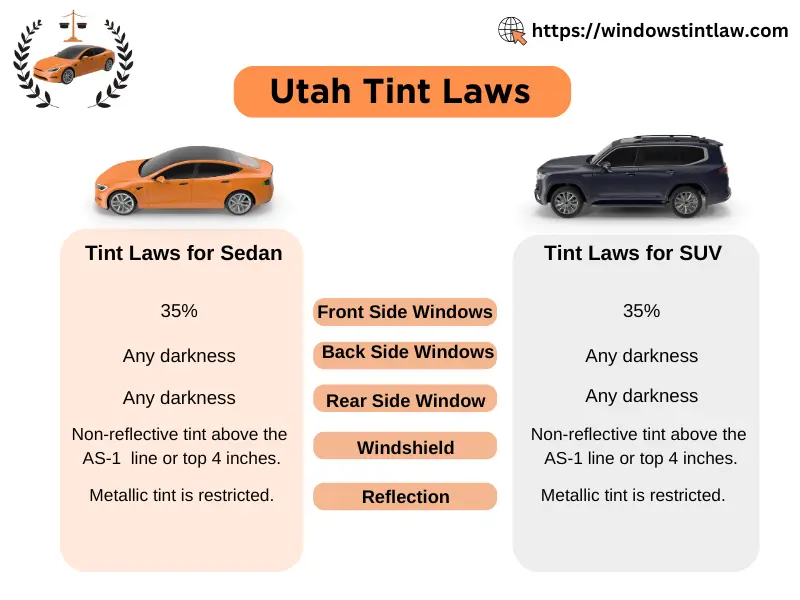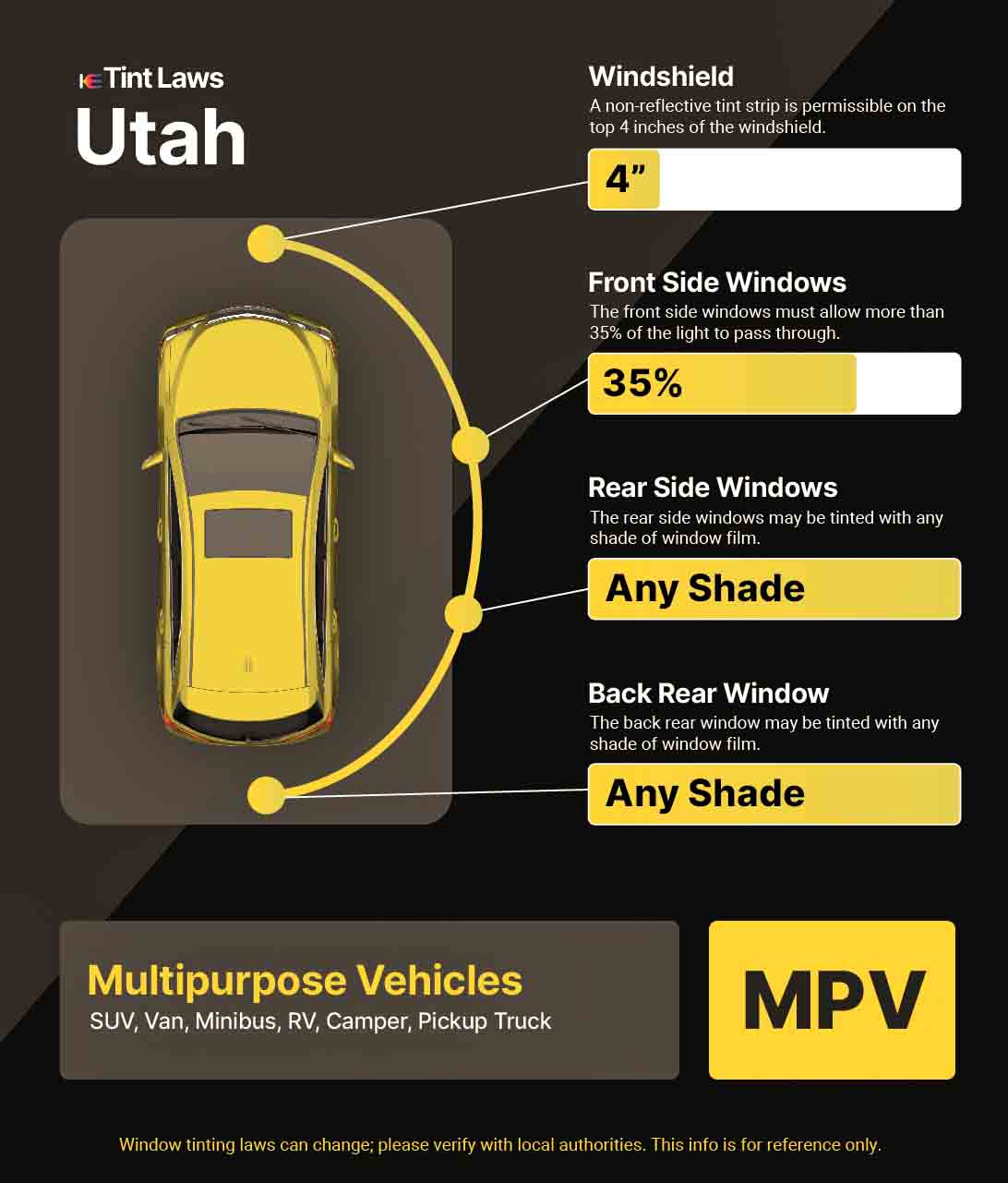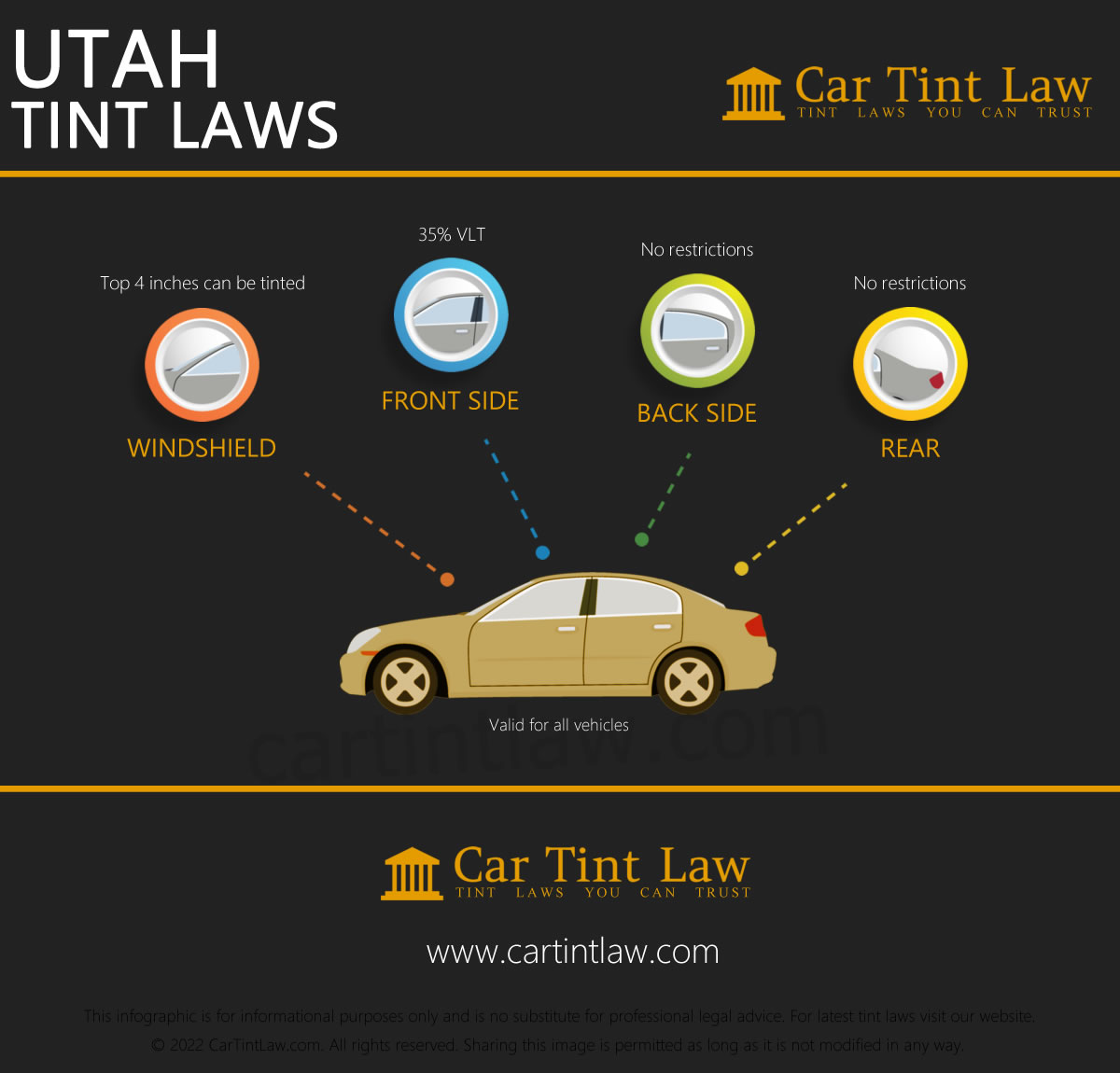Are you considering tinting the windows of your vehicle in Utah? Understanding the Utah tint law is crucial before you make any changes.
Tinting not only enhances your car’s appearance but also provides privacy and protection from UV rays. However, ensuring your tint is legal can save you from costly fines and hassles down the road. You’ll discover everything you need to know about the regulations surrounding window tinting in Utah.
By the end, you’ll feel confident about making informed decisions and avoiding any legal pitfalls. Let’s dive into the details that could impact your driving experience!
Utah Tint Law Basics
Driving through Utah’s stunning landscapes is a treat, but ensuring your vehicle complies with the state’s tint laws is crucial. Understanding the basics of Utah’s tint law can save you from fines and keep your vehicle safe and stylish. Let’s break down the essentials so you can hit the road with confidence.
Legal Tint Percentages
Utah’s tint law specifies different percentages for front and rear windows. For the front side windows, the law permits tinting that allows at least 43% of light to pass through. This means your front windows must be relatively clear, allowing for safe visibility.
Rear windows, however, have more flexibility. You can tint them darker, with no specific percentage restrictions. This is great if you want privacy or to reduce glare, but it’s vital to ensure it doesn’t obstruct your view.
Have you ever wondered why these percentages exist? They balance safety and style, ensuring clear visibility for drivers while allowing personal customization. What percentage suits your needs?
Applicable Vehicles
Utah’s tint laws apply differently to various vehicle types. Passenger cars, for instance, must adhere to the specified tint percentages. This ensures that drivers maintain optimal visibility at all times.
However, if you drive an SUV or a van, the rules are slightly different. These larger vehicles often have rear windows that can be tinted as dark as you like. This flexibility caters to their design and usage, often involving transporting goods or ensuring passenger privacy.
Ever noticed how commercial vehicles seem to have darker tints? They’re often exempt from standard tint laws, allowing for privacy and security in business operations. How does your vehicle fit into these categories?
Understanding these basics empowers you to make informed decisions about window tinting. Whether you’re aiming for aesthetics or functionality, knowing the laws helps you stay compliant and safe. What changes will you consider for your vehicle’s tint?

Credit: windowstintlaw.com
Understanding Vlt
Understanding VLT is crucial for drivers in Utah, where tint laws regulate vehicle window transparency. VLT, or Visible Light Transmission, measures the amount of light passing through tinted windows. Knowing these laws ensures compliance and avoids fines.
Understanding VLT Navigating Utah’s tint laws can be a bit like reading a map without a compass. One essential term you need to grasp is Visible Light Transmission, or VLT. This simple yet crucial concept dictates how much light your window tint allows inside your vehicle. It can significantly affect both visibility and legality. Understanding VLT isn’t just about compliance; it’s about your driving experience. Have you ever driven a car with dark tints at night? It’s like wearing sunglasses in the dark, isn’t it? Knowing the VLT can help you avoid such uncomfortable situations. ###Definition Of Vlt
VLT stands for Visible Light Transmission. It represents the percentage of visible light that passes through your car windows. The higher the VLT percentage, the more light the tint allows in. Think of VLT like a filter. A 70% VLT means 70% of the light can pass through your windows. It’s like having a lightly shaded pair of sunglasses. In contrast, a 5% VLT is akin to wearing dark shades, letting in only minimal light. ###Vlt Requirements In Utah
Utah law specifies different VLT requirements for various windows. For example, the front side windows must have a VLT of at least 43%. This ensures that enough light enters the vehicle, aiding in clear visibility. Back side windows, however, have more lenient requirements. You can opt for a VLT as low as 20% here, allowing for more privacy while still adhering to legal standards. Are you wondering about the rear window? You have the freedom to choose any VLT level. However, keep in mind that darker tints might limit your visibility at night. Understanding these VLT requirements empowers you to make informed decisions. Imagine confidently driving down Utah’s scenic routes, assured that your vehicle meets legal standards, while enjoying the perfect balance of privacy and visibility.Front Window Tint Rules
Utah’s tint law permits front window tinting with at least 70% light transmission. This ensures clear visibility for drivers. Compliance is essential to avoid penalties and maintain safe driving conditions.
Understanding the tint laws in Utah, especially for the front windows, can save you from unexpected fines. The rules are clear, but they often raise questions for drivers seeking that perfect balance between style and legality. Whether you’re considering a sleek new look for your vehicle or just want to ensure compliance, knowing these regulations is crucial. ###Windshield Tint Limitations
When it comes to the windshield, Utah law is quite specific. You are allowed to tint only the top portion of your windshield. This is commonly referred to as a “sun visor strip.” The tint can extend down to the AS-1 line or no more than four inches from the top, whichever is higher. Make sure the tint doesn’t reduce visibility, as safety is a priority. ###Front Side Windows Regulations
For the front side windows, the rules are a bit different. Utah law permits a minimum of 43% light transmission. This means your tint must allow at least 43% of light to pass through. Consider how darker tints might affect your night driving. Would it hinder your ability to see clearly? It’s not just about following the law—it’s about ensuring your safety and the safety of others on the road. When choosing a tint, always check that it meets the state’s light transmission standards. An easy way to verify this is to consult with a professional installer who is familiar with Utah’s tint laws. Have you ever been pulled over for a tint violation? It’s not just inconvenient; it can also be costly. Ensuring your tint is within legal limits saves you trouble and keeps your car looking great. Understanding these rules can also help you make informed decisions about future tinting projects. Whether you’re considering a new look or just want to stay within the law, knowing the specifics of Utah’s front window tint regulations is key.Back Window Tint Regulations
Understanding Utah’s back window tint regulations is crucial for vehicle owners. These rules ensure safety and compliance on the road. Different windows have specific tint requirements. Let’s dive into the regulations for rear side windows and the back windshield.
Rear Side Windows Tinting
In Utah, rear side windows have relaxed tint rules. You can use any darkness level for these windows. This allows for privacy and sun protection. But, always check for any updates in the law. Staying informed ensures compliance with current standards.
Back Windshield Guidelines
The back windshield also allows for flexibility in tint darkness. You can apply any level of tint. But, the vehicle must have dual side mirrors. These mirrors compensate for reduced rear visibility. Always ensure your mirrors are clear and functional. Regular checks can prevent visibility issues.
Reflective And Mirrored Tints
Utah Tint Law regulates reflective and mirrored tints on car windows. Front side windows must allow over 43% light. Rear windows can be darker. Understanding these rules helps drivers avoid fines.
Have you ever driven past a car with windows so shiny it almost looked like a mirror? Reflective and mirrored tints can make vehicles stand out, but they also come with legal considerations. In Utah, understanding the specifics of tint laws can save you from potential fines and ensure your car remains stylish yet compliant.Allowed Reflective Tints
Reflective tints can be a trendy choice for your vehicle. They add a sleek appearance and help reduce glare from the sun. In Utah, you’re permitted to use reflective tint on your windows, but there’s a catch. The law specifies that the reflection must be minimal. If the tint is too shiny, it might not be allowed. This means you can have a bit of reflection, but your car shouldn’t resemble a disco ball on wheels. Have you ever considered how much reflection your tint should have? It’s essential to check the percentage of reflectivity and ensure it adheres to legal limits.Prohibited Tint Styles
While a touch of reflection is acceptable, mirrored tints are generally a no-go in Utah. These tints create a fully reflective surface, making your windows look like mirrors. Why are these prohibited? They can obscure visibility and pose safety concerns for both you and other drivers. Imagine driving and suddenly being blinded by a passing car’s mirrored windows—it’s an accident waiting to happen. Before you choose a tint, ask yourself: is it reflective or mirrored? Knowing the difference can keep your ride stylish and safe on Utah roads.Exceptions To Tint Laws
Utah’s tint laws are pretty straightforward, but did you know there are exceptions that could apply to you? While most vehicles need to adhere to specific guidelines, certain circumstances allow for deviations from the norm. Understanding these exceptions can be crucial, especially if you have unique needs. Let’s dive into some situations where the usual rules might not apply.
Medical Exemptions
Imagine driving with the sun glaring in your eyes, causing discomfort or even pain. If you have a medical condition that makes you sensitive to sunlight, Utah law has provisions for you. You can apply for a medical exemption, allowing darker tint levels on your vehicle. This isn’t just about comfort; it’s about making your driving experience safer.
To qualify, you’ll need documentation from a licensed physician detailing your condition. Once approved, you can enjoy the benefits of reduced sunlight exposure without worrying about legal repercussions. Think about how much easier your daily commute could be if your vehicle catered to your health needs.
Special Vehicle Allowances
Not every vehicle on Utah’s roads is a standard passenger car. Some vehicles have unique purposes that necessitate different tint levels. For instance, you might own a limousine or a hearse. These vehicles often have special allowances under the tint laws.
These allowances recognize the specific functions these vehicles serve, where privacy can be a necessity. If your vehicle falls into this category, you might be eligible for more lenient tint regulations. Isn’t it fascinating how the law adapts to different vehicle needs?
Have you ever considered how these exceptions impact your driving experience or your rights as a vehicle owner? Do these allowances make you feel more empowered to meet your unique needs? Understanding these exceptions could be the key to unlocking a more personalized driving experience.
Penalties For Non-compliance
Understanding Utah’s tint laws is crucial for drivers. Violating these laws can lead to serious penalties. Knowing what to expect helps avoid unnecessary trouble. Let’s dive into the consequences of non-compliance.
Fines And Consequences
Breaking Utah’s tint law results in fines. Fines vary based on the violation’s severity. First-time offenders face smaller fines. Repeat offenders pay higher penalties. The cost can rise significantly.
Beyond fines, other consequences exist. Law enforcement may issue warnings. Persistent violators might face vehicle inspections. Ensuring compliance helps avoid these costly repercussions.
Legal Process
Authorities enforce tint laws strictly. Police officers can stop vehicles for violations. Once stopped, drivers may receive a ticket. This ticket outlines the violation and potential fines.
After receiving a ticket, drivers must address it. Paying fines promptly is essential. Ignoring tickets can lead to court summons. This complicates the legal process further.
In court, drivers present their case. Judges evaluate each situation. They decide on penalties based on evidence. Staying informed on laws helps avoid legal complications.

Credit: kepler-dealer.com
Tips For Legal Tinting
Understanding Utah’s tint laws helps avoid fines and legal trouble. Whether you’re tinting for privacy, style, or sun protection, compliance is key. Use these tips to ensure your vehicle’s tint meets legal standards.
Choosing The Right Tint
Select a tint that aligns with Utah’s legal requirements. In Utah, the front side windows must allow more than 43% of light in. The back side and rear windows have no light transmission restrictions. Choose a tint that balances your needs and legal limits. Consider how much light you want to block. Also, think about the tint’s effect on visibility. A darker tint may look good but can reduce visibility at night.
Professional Installation Advice
Professional installation ensures quality and compliance with Utah laws. Experts use the right tools and materials, providing a clean finish. They know the state’s legal limits and can guide you in choosing the right film. Professional installers also offer warranties, giving you peace of mind. A do-it-yourself job may save money but can lead to mistakes. Poor installation can cause bubbling, peeling, or even fines. Trust professionals for a long-lasting, legal tint.

Credit: www.cartintlaw.com
Frequently Asked Questions
What Is The Darkest Tint Legal In Utah?
Utah law permits a window tint of 43% for the front side windows. Backside and rear windows can have any darkness. Always check local regulations for updates.
In What State Is 20% Tint Legal?
In the United States, 20% tint is legal in states like Florida, Arizona, and California. Laws vary by state, so always check local regulations before tinting your vehicle.
Can A Cop Pull You Over For Tint In Utah?
Yes, a cop can pull you over for window tint violations in Utah. Utah law specifies tint darkness limits. Ensure your tint complies with these regulations to avoid fines. Always check current local laws for updates.
What Is 20 Tint In Utah?
20 tint in Utah means the window allows 20% of light through. It’s common for rear windows and enhances privacy.
Conclusion
Understanding Utah tint laws keeps your car safe and legal. Follow the rules to avoid fines and maintain safety. Each window has different tint limits. Check your car’s tint levels regularly. Darker tints may seem appealing, but they must comply with the law.
Keep your vehicle in line with state regulations. Stay informed about any changes in local tint laws. This knowledge ensures a smooth driving experience. Always prioritize safety and legality on the road. Make responsible choices for a hassle-free journey. Your awareness of these laws benefits everyone.
